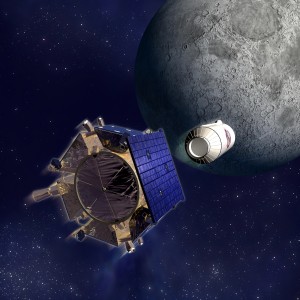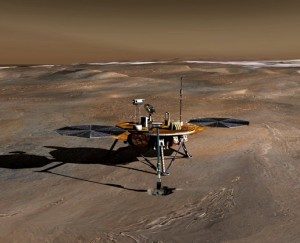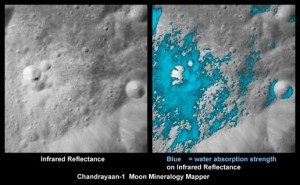 The National Aeronautics and Space Administration declared on July 31 of 2008, that their $420 million (US) dollar Phoenix Mars Lander had struck gold. Or rather they found, through a complex process of gas vapour analysis, that there is in fact water on the Martian surface.[1]
The National Aeronautics and Space Administration declared on July 31 of 2008, that their $420 million (US) dollar Phoenix Mars Lander had struck gold. Or rather they found, through a complex process of gas vapour analysis, that there is in fact water on the Martian surface.[1]
So what’s the big deal you say? After all, 71% percent of the Earth’s surface is covered in Water, or a total liquid volume of approximately 1,360,000,000 km³. All mammalian life on Earth is roughly 60% water. More than half of human food sources come directly from bodies of water, and the rest depends on water for growth, development or refinement. So, water in-and-of-itself is pretty important, but who cares if NASA’s fancy robot found a little bit on a planet that’s more than a million kilometres away?
Before we get to that, let’s clear up a few facts about what was found. After a number of attempts to analyse frozen soil from a two inch deep trench dug by the Lander, success was finally achieved as the soil was exposed to surface “air” for two days, allowing the soil to thaw (in effect) to a point that the sample could be manipulated by the Lander’s instruments. This finding corroborated earlier findings by both the Mars Odyssey Orbiter, and by the Phoenix Lander itself earlier in the mission; both units found evidence of frozen water on the surface of Mars through visual examination, but the July 31 finding is physical contact and analysis of actual Martian Water.
If water on Mars means little to you, then maybe something a little closer to home would be more compelling. In hot pursuit of the Indian Space Research Organization’s Chandrayaan-1, which was successful in identifying deposits of water on the lunar surface this past September, NASA has recently focused the might of their scientific attention on the Moon’s Polar Regions, in hopes of confirming and testing the Chrandrayaan-1 findings.
The search for interstellar water has culminated in a series of unmanned NASA missions to the moon, notably the Moon Mineralogy Mapper, or M3, which provided much the same results as the Chandrayaan-1 mission, and in the wake of those successes, NASA officials have done the unimaginable, or so many people believe. They bombed the Moon.[2]
 Now, while I appreciate and even sympathise with the subsequent movement which criticises NASA for such seemingly aggressive action against our closest galactic neighbour, I do understand their reasons, and I also understand that what they did was not a bombing. The reality of the LCROSS Mission is that, in simple terms, they simply crashed a small satellite into the southern pole region. There were no explosives involved; there was no great weapon and no intent to harm an otherwise inanimate celestial body. Despite the truth, a great many people are displeased with the methods of the LCROSS Mission and unfortunately, the real story is being lost in the propaganda.[3]
Now, while I appreciate and even sympathise with the subsequent movement which criticises NASA for such seemingly aggressive action against our closest galactic neighbour, I do understand their reasons, and I also understand that what they did was not a bombing. The reality of the LCROSS Mission is that, in simple terms, they simply crashed a small satellite into the southern pole region. There were no explosives involved; there was no great weapon and no intent to harm an otherwise inanimate celestial body. Despite the truth, a great many people are displeased with the methods of the LCROSS Mission and unfortunately, the real story is being lost in the propaganda.[3]
That real story is significant and I must say that I’m confused about the public’s general lack of regard for the impact of these discoveries. The real story is an answer to the one question that first propelled man into the heavens; is there life elsewhere in the universe?
I imagine there are a few people still wondering how water comes to equal an increased probability of extraterrestrial life in the universe, and the simple answer is, there is no simple answer. As a crude explanation, one could say that water creates a sort of embryonic environment for single celled organisms, much as our oceans have done for millions of years. Of course there is a lot more to it than that.
The reason NASA began the search for water in the first place, was part of a fast moving cosmically-political shift in thinking, away from searching for little green men and their errant radio signals, to a much more focused and logical search for life, in any form, on planetary objects that are close enough to observe in detail.
 There are several reasons why Mars was the most logical place to direct that focus; the fact that it resides within the habitable zone of solar radiation in our solar system, the fact that it’s close enough to Earth to be reached by humanity in a reasonable amount of time, and the fact that it very closely resembles Earth in composition and size, to name a few. But while NASA’s P-R machine had the world’s attention set squarely on Mars, they were quietly discussing the possibility that the same potential for life could exist on our very own moon.
There are several reasons why Mars was the most logical place to direct that focus; the fact that it resides within the habitable zone of solar radiation in our solar system, the fact that it’s close enough to Earth to be reached by humanity in a reasonable amount of time, and the fact that it very closely resembles Earth in composition and size, to name a few. But while NASA’s P-R machine had the world’s attention set squarely on Mars, they were quietly discussing the possibility that the same potential for life could exist on our very own moon.
On our quest to define why extraterrestrial water is so important to the search for life in the universe, we have to take a much closer look at some of the life that exists on Earth. Micro biology is an area of physical science that gets little to no spotlight recognition. It isn’t particularly exciting, unless you happen to be a micro biologist; it isn’t particularly fast moving, especially in comparison to cosmology, but it does have a few things going for it.
Within the classification index of all known life on Earth, there are many branches of biological diversity, all of which reduce to three main categories. Every known organism, creature and animal on Earth fits into any one of these three classifications; Bacteria, Archaea or Eukarya. The difference between these classifications is as significant as the difference between a single celled virus, a mammal and an invertebrate, but in some cases, the difference between members of one classification can be even greater.
There are some organisms residing in both the Archaea and Eukarya branches that bear a significant amount of weight in the search for extraterrestrial life. Certain species of protists -simply related to bacterium- have been discovered not only surviving in the most inhospitable environments on Earth, but they have actually been thriving in conditions that would mean certain death for any other form of life. Some of these climates are so dangerous that even studying them is hazardous to ones health, such as within the toxic cooling pools of nuclear reactors (and now it seems even directly in nuclear waste, though there is much debate over this recent discovery), or along side ultra-deep sea thermal vents, or even more than a kilometre below the surface of the permanent glaciers in both the north and south poles.[4]
 The life that exists in these conditions is not anything you might recognise, or even be able to see without the use of a powerful microscope, but none the less, these organisms exists, they are thriving and breeding and evolving in these conditions, and the implications presented by these relatively new neighbours of ours on the biological family tree are indeed significant. In each case, these single celled and sometimes complex organisms have adapted their biology to not only endure in what we might call a hostile environment, but they have evolved to a point where they cannot survive outside of those conditions. When you consider the environments in question, you can quickly see a correlation to the harsh terrain and atmospheric conditions found on both the Moon and on Mars.
The life that exists in these conditions is not anything you might recognise, or even be able to see without the use of a powerful microscope, but none the less, these organisms exists, they are thriving and breeding and evolving in these conditions, and the implications presented by these relatively new neighbours of ours on the biological family tree are indeed significant. In each case, these single celled and sometimes complex organisms have adapted their biology to not only endure in what we might call a hostile environment, but they have evolved to a point where they cannot survive outside of those conditions. When you consider the environments in question, you can quickly see a correlation to the harsh terrain and atmospheric conditions found on both the Moon and on Mars.
Extreme radioactivity, extreme atmospheric pressure, extreme cold, extreme heat and zero light; in fact the single common denominator for all of these organisms is water -Two hydrogen atoms covalently bonded to a single oxygen atom. It is the unique use of water molecules by each of these organisms that gives them the ability to endure the poisonous, freezing, and rancid environments they have come to require for survival; and because of that, many cosmologists have taken to adapting their view of space exploration with an eye to micro biology.
In turn, the search for life in the heavens has become a race to finding water anywhere but on Earth, and now that we’ve come full circle I’ll reiterate my earlier confusion; why are so few people talking about the significant impact of discovering water on both the Moon and Mars?
I would be prone to believe that the public at large lacks a basic understanding of the meaning of the discovery of off world water, though it doesn’t seem that there are many within the industry of science journalism or even those learned people in UFO enthusiasm than have caught on to the significance. Essentially, for years science and science-minded theologians have pondered what might be required for life to develop on planetary bodies like Mars, and with some fairly benign disagreement, the top requirement has been touted as the existence of water on those planets. As was shown above, many other factors of environmental concern can be disregarded as having an impact on the possibility for life, if water can be proved to exist, and it would seem that this one requirement has been met, in spades. So where are all the ringing bells, the mass hysteria and the tin foil hats?
I think this may be the point where I lose some readers to an eye roll and an indignant “whatever”; but I’m going to suggest that NASA has other motives, and that the officials of other such scientific entities the world over are hesitant to question those motives for reasons of funding, and even possibly national (or international) security.
In the early years, after the controversial decision made by NASA leadership, to abandon such projects as SETI (which has since been taken to private operation) in favour of searching for life through other means, many UFOlogists and even mainstream cosmologists spoke loud criticisms, arguing that it was actually an attempt to subvert the truth of the situation. A great many people believe that NASA, as an extension of the US Government, has long been aware of the existence of extraterrestrial life, and that this search for water was one of the largest misinformation campaigns ever concocted and perpetrated. If this were the case, and I have no information to declare either way, then the discovery of water on Mars and the Moon would be as insignificant to them as the discovery of ants on the sidewalk outside of your own home.
As always, I ask only that you consider this point of view, and that you ultimately make up your own mind, but hidden in this mess of conspiracy and science is one fact that should not and cannot be lost…water was found on the surface of Mars and the Moon, and in the name of the original purpose behind that discovery, we now know that life can, and most probably has, developed somewhere other than on Earth, and…that life has also thrived and evolved.
[1] For details, see NASA’s website: http://www.nasa.gov/mission_pages/phoenix/news/phoenix-20080731.html
[2] See NASA’s website: http://www.nasa.gov/topics/moonmars/features/moon20090924.html
[3] See LCROSS Mission Overview: http://www.nasa.gov/mission_pages/LCROSS/overview/index.html
[4] See The Living Cosmos, by Chris Impey and/or The Biology of Belief, by Bruce H. Lipton
